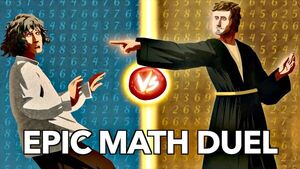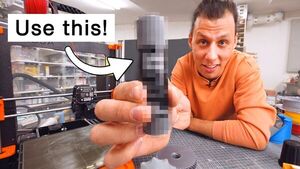2021-11-04 - Nº 340
Editorial
Esta é a Newsletter Nº 340 que se apresenta com o mesmo formato que as anteriores. Se gostar da Newsletter partilhe-a!
Todas as Newsletters encontram-se indexadas no link.
Esta Newsletter tem os seguintes tópicos:
Faz hoje anos que nascia, em 1841, o industrial americano Benjamin Goodrich. Ele fundou a B.F. Goodrich Rubber Co. em Akron, Ohio. Após a Guerra Civil, durante a qual serviu como cirurgião do Exército, Goodrich com J.P. Morris adquiriu a Hudson River Rubber Co. por $5.000,00 ao abrigo de um acordo de licença com Charles Goodyear. Esta empresa, tal como a seguinte, falhou em Melrose, NY. Goodrich mudou-se para Akron e iniciou uma parceria, a Goodrich, Tew and Co., em 31 de Dezembro de 1870 e começou a fabricar produtos de borracha como mangueiras de incêndio, cintos industriais e pneus de bicicleta em 19 de Fevereiro de 1871. Após a sua reorganização (1874), a Companhia B.F. Goodrich foi incorporada em 1880.
Faz também hoje anos que nascia, em 1929, a indiana Shakuntala Devi. Ela ficou conhecida como o computador humano. Desde os seus seis anos que, em publico, fazia demonstrações das suas capacidades de adicionar rapidamente numero até 13 dígitos. Usando as suas capacidades mentais, ela aplicou atalhos usando algoritmos matemáticos, embora não conseguisse explicar essa capacidade. Os seus cálculos incluíram a utilização de grandes números em multiplicação e divisão de grandes números. Ela também rapidamente deu raízes quadradas e em cubos, e podia nomear o dia da semana para qualquer data do século passado. Exemplos incluem tomar a raiz cúbica de 188.132.517 ou nomear os dias da semana em que o 14º dia de cada mês ocorreu em 1935. A sua habilidade era de cálculo, mas não tinha memória fotográfica para outros factos, e podia ter lapsos de memória como o reconhecimento de pessoas encontradas em anos passados.
Em 1845, Michael Faraday, a trabalhar no seu laboratório no Royal Institution, pendurou um pedaço de vidro pesado entre os postes de um electroíman e observou que o vidro se alinhou através das linhas de força do íman. Fez ainda experiências com muitas outras substâncias, com resultados semelhantes, um fenómeno a que deu o nome de dia-magnetismo. Estas investigações mostraram a Faraday que o magnetismo era inerente à matéria. Isto levou à sua palestra "Thoughts on Ray-vibrations", em Abril de 1846, que expandiu nos anos seguintes na sua teoria de campo do electromagnetismo.
Em 1939, o primeiro automóvel com ar condicionado foi exposto pelo seu fabricante, Packard Motor Co. de Detroit Michigan. A exposição pública no 40º Salão Automóvel em Chicago, Illinois, decorreu entre 4-12 de Novembro. O ar no carro foi arrefecido, desumidificado, filtrado e circulado. O calor foi fornecido para utilização no Inverno. As serpentinas frigoríficas estavam localizadas atrás do assento traseiro numa conduta de ar, com serpentinas de aquecimento num outro compartimento da mesma conduta. A capacidade da unidade era equivalente a 1,5 toneladas de gelo em 24 horas, quando o carro era conduzido a cerca de 100 km/h.
Nesta semana que passou foi lançada a nova versão da distribuição do sistema Linux, o Fedora 35. Vocacionado para o Desktop, em particular para programadores de software esta versão apresenta como novidades o GNOME 41, que inclui melhorias na gestão de energia, introduz o Connections que é um novo cliente para ligações remotas VNC e RDP. Também os principais pacotes de linguagens de programação foram actualizados incluindo o Python 3.10, o Perl 5.34 e o PHP 8.0.
Na Newsletter desta semana apresentamos diversas noticias, artigos científicos, projetos de maker assim como alguns videos interessantes.
 João Alves ([email protected])
João Alves ([email protected])
O conteúdo da Newsletter encontra-se sob a licença  Creative Commons Attribution-NonCommercial-ShareAlike 4.0 International License.
Creative Commons Attribution-NonCommercial-ShareAlike 4.0 International License.
Novidades da Semana

Worth the wait: Fedora Linux 35 is here!
"Today, I’m excited to share the results of the hard work of thousands of Fedora Project contributors: our latest release, Fedora Linux 35, is here! While we broke our six-release streak of on-schedule releases, we felt it was more important to resolve a few outstanding blocking bugs. Fedora believes that software has to be usable to be useful, so while we know that a predictable schedule is important, we also ensure that every release meets our criteria, no matter what the calendar says. A Fedora Linux for every use case Fedora Editions are targeted outputs geared toward specific “showcase” uses on the desktop, in server & cloud environments, and for the Internet of Things. Fedora Workstation focuses on the desktop, and in particular, it’s geared toward software developers who want a “just works” Linux operating system experience. This release features GNOME 41, which builds on the reimagining of desktops in GNOME 40 (which shipped in Fedora Workstation 34)." [...]
Outras Notícias

New buck/boost converter maintains industry's lowest IQ while integrating supercapacitor charging
"Engineers can extend battery life by up to 20% in low-power industrial applications with new DC/DC converter from TI Texas Instruments (TI) (Nasdaq: TXN) today introduced a new bidirectional buck/boost converter with an ultra-low quiescent current (IQ) of 60 nA – one-third the IQ of competing boost converters. The TPS61094 buck/boost converter integrates a buck mode for supercapacitor charging while providing ultra-low IQ, enabling engineers to extend battery life by as much as 20% when compared to commonly used hybrid-layer capacitors (HLCs). Supercapacitor charging and discharging helps support peak loads and backup power, which are important for continuous operation in battery-powered industrial applications such as smart meters, smoke detectors and video doorbells, as well as medical applications. For more information, see www.ti.com/tps61094-pr. Engineers designing battery-operated systems frequently face a common design challenge: a need to achieve high efficiency at no- or light-load conditions, in the low milliampere or microampere range. This requires power supplies to regulate their output while maintaining ultra-low supply current in the nanoampere range." [...]
Ciência e Tecnologia

Exotic magnetic states on the nanoscale
"The UPV/EHU-University of the Basque Country is collaborating on a research project, published in Nature and which could open the door to building quantum computers An international research team, led by scientists from the EMPA (Zurich) and the International Iberian Nanotechnology Laboratory, which has researchers from the UPV/EHU, has succeeded in building chains of quantum magnets made of nanographene that capture the essence of one of the core models of quantum magnetism. The team's results have implications for understanding quantum magnetism on the nanoscale and may open the door to building quantum computers. We are all used to the idea that simple units combine to form more complex structures. So atoms combine to form molecules, which in turn combine to form cells, and cells form tissue, ultimately giving rise to living beings. In the quantum world, this process may take place in reverse in such a way that the interaction between complex particles results in simpler particles. So, under certain circumstances, the interaction between electrons, indivisible particles with electric charge e, gives rise to the emergence of particles with charge e/3." [...]
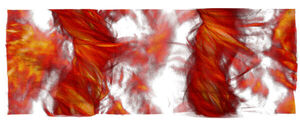
3D simulations improve understanding of energetic-particle radiation and help protect space assets
"A team of researchers used 3D particle simulations to model the acceleration of ions and electrons in a physical process called magnetic reconnection. The results could contribute to the understanding and forecasting of energetic particles released during magnetic reconnection, which could help protect space assets and advance space exploration. “For the first time ever, we can use 3D simulations from fundamental physics principles to model the production of energetic ions and electrons in those magnetic explosions in space,” said paper author Qile Zhang, of the Nuclear and Particle Physics, Astrophysics and Cosmology group at Los Alamos National Laboratory. The research was published in Physical Review Letters. Magnetic reconnection can cause magnetic explosions, which result in events such as solar flares and geomagnetic storms near Earth; these explosions produce energetic-particle radiation that is harmful to spacecraft and humans. The research team discovered the underlying mechanisms controlling particle acceleration enabled by the 3D kink motions of plasmas – the collection of charged particles – and magnetic fields." [...]
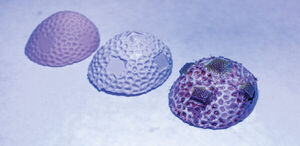
3D printing frames a restoration for coral
"Coral restoration could become easier and quicker with the use of 3D printing. As the technology matures, it could be used to rapidly and reliably create support structures for corals to grow on. Coral reefs around the world are suffering from warming oceans and increasing pollution. Reef restoration efforts employ concrete blocks or metal frames as substrates for coral growth. The resulting restoration is slow because corals deposit their carbonate skeleton at a rate of just millimeters per year. Charlotte Hauser and her team are exploring the use of 3D printing to speed up the process." [...]

Engineers report a major advance in creating a new family of semiconductor materials
"Ultrastable and made of inexpensive, nontoxic elements, chalcogenide perovskites could find applications in solar cells, lighting, and more. MIT engineers report creating the first high-quality thin films of a new family of semiconductor materials. The feat, which lead researcher Rafael Jaramillo refers to as his “white whale” because of his obsession in pursuing it over the years, has the potential to impact multiple fields of technology if history repeats itself. The ability to create high-quality films of other families of semiconductors led to computers, solar cells, night-vision cameras, and more. When introducing a new material, “the most important scientific breakthroughs are enabled only when we have access to the highest-quality materials available,” says Jaramillo, the Thomas Lord Associate Professor of Materials Science and Engineering at MIT. “Studying materials of low quality often results in false negatives with respect to their scientific interest and technological potential.” The new family of semiconductors, known as chalcogenide perovskites, could have applications in solar cells and lighting, Jaramillo says." [...]
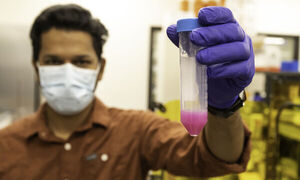
Researchers develop novel 3D printing technique to engineer biofilms
"The research may aid in developing drugs to fight the negative effects of these microorganisms that adhere to surfaces. Anne S. Meyer, an associate professor of biology at the University of Rochester, and her collaborators at Delft University of Technology in the Netherlands, recently developed a 3D printing technique to engineer and study biofilms—three-dimensional communities of microorganisms, such as bacteria, that adhere to surfaces. The research provides important information for creating synthetic materials and in developing drugs to fight the negative effects of biofilms. Biofilms can be both harmful and beneficial to humans: they can coat the surfaces of materials and objects, including medical devices, and cause infections, and they are resistant to many drugs and disinfectants. However, biofilms are able to degrade toxic chemicals and environmental pollutants, making them useful in areas such as wastewater treatment. In their latest research, published in the journal ACS Synthetic Biology, Meyer and her colleagues show that engineered biofilms can behave like natural ones." [...]

Plastic-eating bacteria could help aid global recycling efforts
"Bacteria which have been shown to degrade and assimilate plastic, has been a key area of international research since 2016. Now a University of Manchester-based team of scientists have made a biotechnological breakthrough which may help humans to call on engineered bacteria cells to reduce our plastic waste. PET plastic has long been a concern due to the sheer volume of plastic created globally and its impact through non-recycled waste on the environment of drinking bottles, take-away containers and micro plastics. Part of the reason plastic is difficult to break down is its chemical structure, which is made up of monomers – small molecules which are bonded together to form polymers. To date there have been many studies on the ability of bacteria to degrade PET plastic down into the constituent monomers. However, there has been limited study on the ability of these bacteria to recognise and uptake the corresponding monomers into their cells." [...]
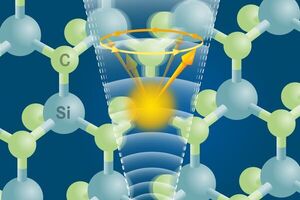
Trapping spins with sound
"Acoustic manipulation of electron spins could lead to new methods of quantum control Color centers are lattice defects in crystals that can capture one or more additional electrons. The spin of these electrons is very sensitive to external electric and magnetic fields – and to sound. Researchers from the Paul-Drude-Institut für Festkörperelektronik in Berlin, the Helmholtz-Zentrum Dresden-Rossendorf (HZDR) and the Ioffe Institute in St. Petersburg are reporting now in Science Advances (DOI: 10.1126/sciadv.abj5030) the selective manipulation of electron spins in both their ground and excited states with sound. Their approach opens the path to new methods for processing quantum information inaccessible so far. The captured electrons typically absorb light in the visible spectrum, so that a transparent material becomes colored under the presence of such centers, for instance in diamond. “Color centers are often coming along with certain magnetic properties, making them promising systems for applications in quantum technologies, like quantum memories – the qubits – or quantum sensors." [...]
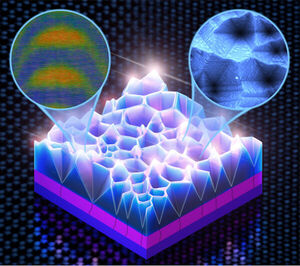
A new way to generate light using pre-existing defects in semiconductors
"SMART researchers demonstrate a practical way to make indium gallium nitride LEDs with considerably higher indium concentration. Researchers from the Low Energy Electronic Systems (LEES) interdisciplinary research group at the Singapore-MIT Alliance for Research and Technology (SMART), MIT’s research enterprise in Singapore, together with collaborators at MIT, National University of Singapore (NUS), and Nanyang Technological University (NTU), have discovered a new method of generating long-wavelength (red, orange, and yellow) light using intrinsic defects in semiconducting materials, with potential applications as direct light emitters in commercial light sources and displays. This technology would be an improvement on current methods, which use phosphors, for instance, to convert one color of light to another. A type of group-III element nitride-based light-emitting diode (LED), indium gallium nitride (InGaN) LEDs were first fabricated over two decades ago in the 1990s, and have since evolved to become ever-smaller while growing increasingly powerful, efficient, and durable. Today, InGaN LEDs can be found across myriad industrial and consumer use cases, including signals and optical communication and data storage — and are critical in high-demand consumer applications such as solid state lighting, television sets, laptops, mobile devices, and augmented- and virtual-reality solutions. Ever-growing demand for such electronic devices has driven over two decades of research into achieving higher optical output, reliability, longevity, and versatility from semiconductors — leading to the need for LEDs that can emit different colors of light." [...]
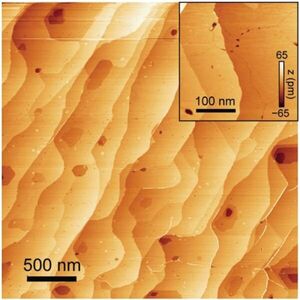
Spintronics: Exotic ferromagnetic order in two-dimensions
"An international team has detected at HZB's vector magnet facility VEKMAG an unusual ferromagnetic property in a two-dimensional system, known as “easy-plane anisotropy”. This could foster new energy efficient information technologies based on spintronics for data storage, among other things. The team has published its results in the renowned journal Science. The thinnest materials in the world are only a single atom thick. These kinds of two-dimensional or 2D materials – such as graphene, well-known as consisting of a single layer of carbon atoms – are causing a great deal of excitement among research teams worldwide. This is because these materials promise unusual properties that cannot be obtained using three-dimensional materials." [...]
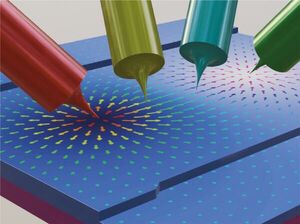
Material for Future Quantum Computers: Researchers Measure Ultra-Thin Topological Insulators
"Physicists at Forschungszentrum Jülich have made a significant step towards the realisation of new types of electronic components. Using a special four-tip scanning tunnelling microscope, they were able to directly measure the extraordinary electrical properties that exist in ultra-thin topological insulators for the first time. These properties result from the fact that the electron spin is coupled to the direction of the electric current, and enables realisation of a topological quantum computer. The decoherence quantum bits, or qubits for short, is one of the main hurdles in the construction of practically usable quantum computers. So-called topological quantum computers are considered an elegant and promising solution to this problem. The sensitive quantum information in such a computer is particularly well protected against errors by the choice of certain materials." [...]
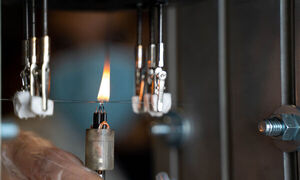
Aircraft can get higher and greener from doped fuels
"UBCO researchers cook up cleaner jet fuel with graphene nanomaterials The goal of creating a cleaner fuel for aircraft engines is creating a spark at UBC Okanagan. A team of researchers studying the burning rate of nanomaterials in liquid fuels believe they have created a recipe for clean-burning, power-boosting aircraft fuel. The project is a collaboration between the School of Engineering’s Combustion for Propulsion and Power Laboratory (CPPL) and its Nanomaterials and Polymer Nanocomposites Laboratory. Inside the CPPL, researchers watch a bright consistent flame as it dances over wires containing droplets of liquid fuel enriched with nanomaterials. The team is investigating the combustion characteristics of microscopic graphene oxide inside fuel. Their experiment measures the ignition delay, burn rate and speed by which the graphene particles and fuel separate into smaller particles." [...]
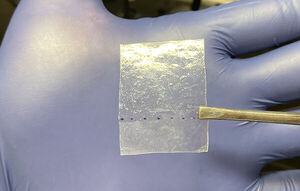
Researchers Discover Another Way To Sequester Lead in Perovskite Solar Cells
"Scientists at the National Renewable Energy Laboratory (NREL) and Northern Illinois University (NIU) have successfully prevented lead from escaping damaged perovskite solar cells. The research effort is their latest work in addressing concerns about potential lead toxicity. The light-absorbing layer in perovskite solar cells contains a small amount of lead. Simply encapsulating solar cells does not stop lead from leaking if the device were to become damaged by severe weather conditions, such as a hailstorm. Instead, chemical absorption holds the key. The researchers report being able to capture more than 99.9% of leakage." [...]

Innovative chip built by UCPH physicists resolves quantum headache
"Quantum physicists at the University of Copenhagen are reporting an international achievement for Denmark in the field of quantum technology. By simultaneously operating multiple spin qubits on the same quantum chip, they surmounted a key obstacle on the road to the supercomputer of the future. The result bodes well for the use of semiconductor materials as a platform for solid-state quantum computers. One of the engineering headaches in the global marathon towards a large functional quantum computer is the control of many basic memory devices – qubits – simultaneously. This is because the control of one qubit is typically negatively affected by simultaneous control pulses applied to another qubit. Now, a pair of young quantum physicists at the University of Copenhagen’s Niels Bohr Institute –PhD student, now Postdoc, Federico Fedele, 29 and Asst." [...]

Creating dynamic symmetry in quantum systems
"MIT researchers develop a new way to control and measure energy levels in a diamond crystal; could improve qubits in quantum computers. Physicists and engineers have long been interested in creating new forms of matter, those not typically found in nature. Such materials might find use someday in, for example, novel computer chips. Beyond applications, they also reveal elusive insights about the fundamental workings of the universe. Recent work at MIT both created and characterized new quantum systems demonstrating dynamical symmetry — particular kinds of behavior that repeat periodically, like a shape folded and reflected through time. “There are two problems we needed to solve,” says Changhao Li, a graduate student in the lab of Paola Cappellaro, a professor of nuclear science and engineering." [...]
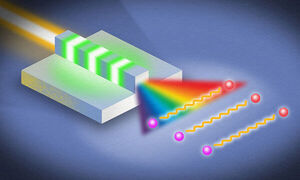
Rochester researchers set ‘ultrabroadband’ record with entangled photons
"The engineers have achieved unprecedented bandwidth and brightness on chip-sized nanophotonic devices. Quantum entanglement—or what Albert Einstein once referred to as “spooky action at a distance”— occurs when two quantum particles are connected to each other, even when millions of miles apart. Any observation of one particle affects the other as if they were communicating with each other. When this entanglement involves photons, interesting possibilities emerge, including entangling the photons’ frequencies, the bandwidth of which can be controlled. Researchers at the University of Rochester have taken advantage of this phenomenon to generate an incredibly large bandwidth by using a thin-film nanophotonic device they describe in Physical Review Letters. The breakthrough could lead to: Enhanced sensitivity and resolution for experiments in metrology and sensing, including spectroscopy, nonlinear microscopy, and quantum optical coherence tomography Higher dimensional encoding of information in quantum networks for information processing and communications “This work represents a major leap forward in producing ultrabroadband quantum entanglement on a nanophotonic chip,” says Qiang Lin, professor of electrical and computer engineering." [...]
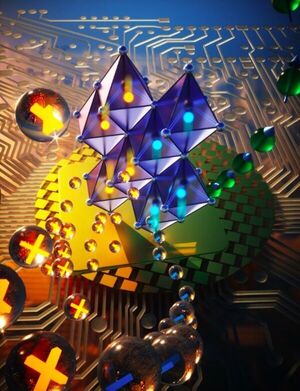
Room-temperature switching of spin-to-charge conversion in ferroelectric semiconductors
"An international team of researchers coordinated by Christian Rinaldi from Politecnico di Milano has unveiled the potential of germanium telluride (GeTe) for ultralow-power spin-based electronics. These findings were reported in the Nature Electronics issue of October 2021 (click here for a view-only full-text access). GeTe is the prototype of the class of materials called ferroelectric Rashba semiconductors (FERSC), originally discovered by the group of Silvia Picozzi at CNR-SPIN (including Domenico Di Sante and Paolo Barone) and one of the technological pillars investigated in the PRIN 2017 project “TWEET” she coordinates. Rashba ferroelectric semiconductors have a Rashba-like spin-splitting of some electronic bands determined by the broken inversion symmetry connected to the ferroelectric displacement. Thus, there is a one-to-one relationship between the orientation of the ferroelectric polarization and their Rashba spin texture, allowing to envisage the electric control of spins in the semiconductor [see Fig. a) and b)]." [...]
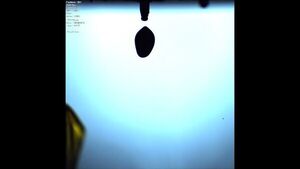
LLNL team develops real-time diagnostic for Liquid Metal Jetting 3D printing
"As 3D printing continues to grow and evolve, diagnostics capable of monitoring builds in real-time have become essential tools for producing quality parts, particularly in emerging printing technologies such as Liquid Metal Jetting (LMJ). In LMJ, tiny molten metal droplets are ejected from a nozzle at high speeds to 3D print a part in layers, similar to inkjet printers on the consumer market. Unlike laser-based metal 3D printing processes, the technology doesn’t require metal powder, which can be hazardous to handle and wasteful of material. Diagnostics used today to ensure high-quality LMJ prints largely rely on high-speed videography, which requires expensive equipment, can be difficult to set up and generates large amounts of data. While adequate for evaluating a few seconds of a test printing, it isn’t a feasible solution for longer builds. Researchers at Lawrence Livermore National Laboratory (LLNL) are attempting to solve the problem with a new diagnostic tool that can determine the quality of metal droplets and monitor LMJ prints in real time." [...]

Quantifying Spin In WTE2 For Future Spintronics
"A RMIT-led, international collaboration published this week has observed large in-plane anisotropic magnetoresistance (AMR) in a quantum spin Hall insulator and the spin quantization axis of the edge states can be well-defined. A quantum spin Hall insulator (QSHIs) is a two-dimensional state of matter with an insulating bulk and non-dissipative helical edge states that display spin-momentum locking, which are promising options for developing future low-energy nano-electronic and spintronic devices. The FLEET collaboration of researchers at RMIT, UNSW and South China Normal University (China) confirm for the first time the existence of large in-plane AMR in monolayer WTe2 which is a novel QSHI with higher critical temperatures. By allowing electrical conduction without wasted dissipation of energy, such materials could form the basis of a new future generation of ultra-low energy electronics. FABRICATING MONOLAYER WTE2 DEVICES The rise of topological insulators has offered significant hope for researchers seeking non-dissipative transport, and thus a solution to the already observed plateauing of Moore’s law. Unlike previously-reported quantum-well systems, which could only exhibit quantized edge transport at low temperatures, the recent observation of quantized edge transport at 100 K in a predicted large band-gap QSHI, monolayer WTe2 , has shed more light on the applications of QSHI." [...]

A new dimension in magnetism and superconductivity launched
"An international team of scientists from Austria and Germany has launched a new paradigm in magnetism and superconductivity, putting effects of curvature, topology, and 3D geometry into the spotlight of next-decade research. | New paper in "Advanced Materials". Traditionally, the primary field, where curvature is playing a pivotal role, is the theory of general relativity. In recent years, however, the impact of curvilinear geometry enters various disciplines, ranging from solid-state physics over soft-matter physics to chemistry and biology, giving rise to a plethora of emerging domains, such as curvilinear cell biology, semiconductors, superfluidity, optics, plasmonics and 2D van der Waals materials. In modern magnetism, superconductivity and spintronics, extending nanostructures into the third dimension has become a major research avenue because of geometry-, curvature- and topology-induced phenomena. This approach provides a means to improve conventional and to launch novel functionalities by tailoring the curvature and 3D shape." [...]
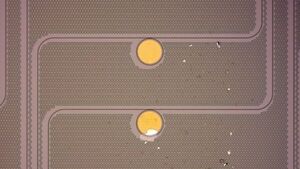
Researchers Move Closer to Controlling Two-dimensional Graphene
"The results relied on a cleaner technique to manipulate the flow of electricity, giving graphene greater conductivity than metals such as copper and gold, and raising its potential for use in telecommunications systems and quantum computers. The device you are currently reading this article on was born from the silicon revolution. To build modern electrical circuits, researchers control silicon’s current-conducting capabilities via doping, which is a process that introduces either negatively charged electrons or positively charged "holes" where electrons used to be. This allows the flow of electricity to be controlled and for silicon involves injecting other atomic elements that can adjust electrons— known as dopants—into its three-dimensional (3D) atomic lattice. Silicon’s 3D lattice, however, is too big for next-generation electronics, which include ultra-thin transistors, new devices for optical communication, and flexible bio-sensors that can be worn or implanted in the human body. To slim things down, researchers are experimenting with materials no thicker than a single sheet of atoms, such as graphene." [...]

NREL Researchers Point Toward Energy Efficiency Instead of Long-Term Storage
"Incorporating energy efficiency measures can reduce the amount of storage needed to power the nation’s buildings entirely with renewable energy, according to analysis conducted by researchers at the U.S. Department of Energy’s (DOE’s) National Renewable Energy Laboratory (NREL). As more communities plan to eventually rely on 100% renewable energy, the researchers offer a strategy that could guide their paths—one that shifts away from long-duration storage. “Minimizing long-duration storage is a key element in trying to achieve the target cost-effectively,” said Sammy Houssainy, co-author with William Livingood of a new paper that outlines an approach to 100% renewables. The research paper, “Optimal Strategies for a Cost-Effective and Reliable 100% Renewable Electrical Grid,” appears in the Journal of Renewable and Sustainable Energy. The researchers considered solar and wind as the source of renewable energy, given that most plans for meeting the 100% target take those into account. They also used the Department of Energy’s EnergyPlus and OpenStudio building energy modeling tools to simulate energy demand, considering such factors as building size, age, and occupancy type." [...]
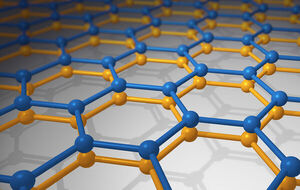
Physicists Discover Novel Quantum Effect in Bilayer Graphene
"Theorists at The University of Texas at Dallas, along with colleagues in Germany, have for the first time observed a rare phenomenon called the quantum anomalous Hall effect in a very simple material. Previous experiments have detected it only in complex or delicate materials. Dr. Fan Zhang, associate professor of physics in the School of Natural Sciences and Mathematics, is an author of a study published on Oct. 6 in the journal Nature that demonstrates the exotic behavior in bilayer graphene, which is a naturally occurring, two-atom thin layer of carbon atoms arranged in two honeycomb lattices stacked together. The quantum Hall effect is a macroscopic phenomenon in which the transverse resistance in a material changes by quantized values in a stepwise fashion. It occurs in two-dimensional electron systems at low temperatures and under strong magnetic fields." [...]
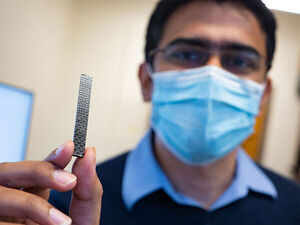
Healable carbon fiber composite offers path to long-lasting, sustainable materials
"Because of their high strength and light weight, carbon-fiber-based composite materials are gradually replacing metals for advancing all kinds of products and applications, from airplanes to wind turbines to golf clubs. But there’s a trade-off. Once damaged or compromised, the most commonly-used carbon fiber materials are nearly impossible to repair or recycle. In a paper posted this week in the journal Carbon, a research team that includes UW mechanical engineering Assistant Professor Aniruddh Vashisth describes a new type of carbon fiber reinforced material that is as strong and light as traditionally used ones but can be repeatedly healed with heat, reversing any fatigue damage and providing a way to break it down and recycle it when it reaches the end of its life. “Developing fatigue-resistant composites is a major need in the manufacturing community,” says Vashisth. “In this paper, we demonstrate a material where either traditional heat sources or radio frequency heating can be used to reverse and postpone its aging process indefinitely.” The material is part of a recently developed group known as carbon fiber reinforced vitrimers (vCFRP)." [...]

No more magnets: How an electrically driven, linear optical isolator on-a-chip opens door to new applications
"Traditional computers are fast, but nothing like the speed of light-at 186,000 miles per second, you can crunch numbers awfully quick. Thatâs a big reason why optical photonics are being used for photonic integrated circuits (PICs) to greatly increase bandwidth and speed. “Integrated photonics—using light, and photons, instead of traditional electronics and electrons—has enabled chip-scale, compact optical systems with portable weight and low power consumption,” said Sunil Bhave, professor of electrical and computer engineering at The Elmore Family School of Electrical and Computer Engineering. “This has already been translated from tabletop research to commercial products—like chip-scale atomic clocks, light detection and ranging (LiDAR) systems for autonomous vehicles, photonic quantum computing that operates at room temperature, and on-chip spectroscopy for medical diagnosis, among others.” But the integration of on-chip optical gain elements—crucial to the laser’s ability to increase optical power—requires increased optical isolation, to protect the lasers from on-chip reflections, where the light can be reflected back onto the optical source and damage the equipment. In traditional optics, magnetic materials and external bias magnetic fields are used to achieve this optical isolation through the magneto-optical phenomenon known as the Faraday effect, discovered by English scientist Michael Faraday in 1845. “However, the magnetic materials are not compatible with current semiconductor foundry processes—crucial for commercial manufacture at scale—and electrically driven optical isolators are highly desired,” Bhave says." [...]
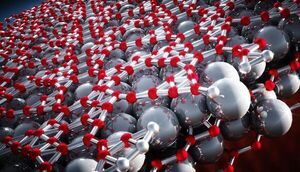
Disorder in surface materials key to better hydrogen storage
"Lawrence Livermore National Laboratory (LLNL) scientists have found that atomic disorder in certain boron-based hydrogen storage systems can potentially improve the rate of hydrogen uptake. Metal boride surfaces and their single-layer variants — known as borophenes — are generally thought to feature a regular arrangement of atoms at low to moderate temperatures. The LLNL team proved that in many cases, these atoms actually disorder dynamically: a surprising phenomenon in contrast to conventional understanding of how most solid-state surfaces behave. The surface disorder means each atomic site has different local properties. According to the team’s research, some of these sites can make dissociation of hydrogen molecules easier, which in turn is expected to accelerate activation of the material during hydrogen storage. The findings have implications for other applications, too." [...]

Creating solar cells and glass from wood – or a billion tons of biowaste
"Researchers map out how biomass from plants could replace unrenewable resources in optical applications A digital, urbanised world consumes huge amounts of raw materials that could hardly be called environmentally friendly. One promising solution may be found in renewable raw materials, according to research published in Advanced Materials. In their paper, the international research group has taken a close look at how lignocellulose — or plant biomass — can be used for optical applications, potentially replacing commonly used materials like sand and plastics. ‘We wanted to map out as comprehensively as possible how lignocellulose could replace the unrenewable resources found in widely used technology, like smart devices or solar cells,’ says Jaana Vapaavuori, assistant professor of functional materials at Aalto University, who carried out the analysis with colleagues at the University of Turku, RISE – Research Institute of Sweden, and University of British Columbia. Lignocellulose, the term that encompasses cellulose, hemicellulose and lignin, is found in nearly every plant on Earth. When scientists break it down into very small parts and put it back together, they can create totally new, usable materials." [...]
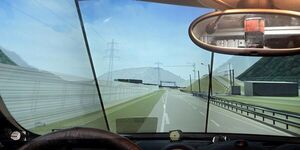
Autonomous Driving: Styrian Development Saves Millions in Test Kilometres
"TU Graz, JOANNEUM RESEARCH, AVL and Fraunhofer Austria have developed a method to validate test drives through highly realistic driving simulation studies and to substantially simplify the approval process for automated driving systems. Driving simulator tests are popular – for understandable reasons: any scenario can be simulated at the touch of a button. They are independent of time and weather conditions and without any safety risk for the vehicle, people or the environment. Moreover, an hour in the driving simulator is cheaper and requires less organization than a real driving lesson on a test track. "In the field of highly automated driving, however, driving simulator studies are often questioned because of the lack of realism. In addition, until recently there were no standardized test procedures that could have been used to check complex tasks such as the mutual interaction between human and system (handover procedures)," says Arno Eichberger, head of the research area "Automated Driving & Driver Assistance Systems" at the Institute of Automotive Engineering at Graz University of Technology (TU Graz)." [...]
Projetos Maker
Diversos Projetos interessantes.

Arduino Piano Tuner Helper
"Many electronic tuning devices are on the market. The cheaper ones are designed for specific instruments (such as guitar, violin). The more expensive ones often are called 'orchestral tuner', piano tuning included. For example, the Korg OT-120 (€ 62) or the Seiko SMP100 (€ 59). Considering the prices of tuners specifically for harpsichords and pianos, I suppose they are targeted at professionals: For instance the Jahn CTS-5-C (€ 718), Jahn CTS-7-C (€ 979) and Jahn CTS-7-CE (€ 1390). All these latter models have at least two displays: the one showing the deviation in cents (which will be explained later), note name and frequency, and the other display showing a stroboscopic indicator (indicating whether you're tuning too low or too high)." [...]
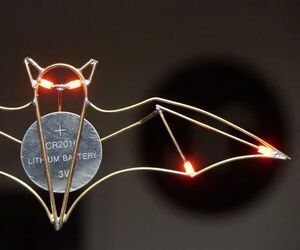
Halloween Badges
"This is a follow up instruction for my LED jewelry. This time I bring you my Halloween collection - a bat, spider and ghost. Make yourself a unique Halloween badge that will glow in the dark. This time I made a video for you! The key to success is proper material and tools. Here is what you gonna need." [...]
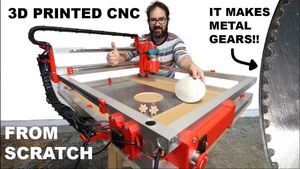
DIY-CNC-machine
"How to build your own CNC machine from scratch This guide goes through all the steps to build your own CNC machine from scratch. It includes a complete bill of materials (BOM), STL/OBJ-files for all the 3d-printed parts and detailed instructions of how everything is assembled. It also includes instructions of how all the necessary open-source softwares are installed. " [...]

Gear Clock 2
"A 3D printed clock driven by a single stepper motor using gears to separate hours, minutes and seconds. This build replaces the electronics used in the Arduino Gear Clock by Tada3. The Arduino Nano module and ULN2003A stepper motor driver module has been replaced with a ATtiny1614 microprocessor and 4 MOSFETs. All components are surface mount and fit on a board with the same form factor as the Arduino Nano module. 3D Printing There are no changes to the STL files provided by Tada3. You can obtain the files from Thingiverse." [...]

Halloween Shield
"The night before a Halloween party I thought - wouldn't it be cool to add a sound-responsive element to my costume? The Prelude Preparing for a student "Fancy Dress" party can be a real challenge. I always struggle with finding an original and fun costume, as the majority of my ideas end up too generic, not achievable with my make-up skills, or most likely both. This Halloween wasn't an exception. But the night of October 30th it dawned on me: I have an Arduino and a ton of LEDs in my electronics box. Thematic Fairy Lights always improve a party costume, and by adding a little sound sensor we can spice this idea up a little." [...]

Disconnected CO2 Data Logger
"Have you ever wondered what the air quality is around you while you're out and about? With this project, you'll be able to monitor CO2 levels and log them, like an IoT device, but without having to worry about connecting to a network. This means you can collect data from places like public transit, concert venues or even on your bike ride. " [...]

The Pomodoro Tomato
"As I was getting into the back to school mood this year, I was researching effective study habits and came across a technique called the Pomodoro Technique that caught my attention. The way it works is you work for 25 minutes straight, then take a 5 minute break. Then you set the timer for another 25 minutes and the process repeats. Each cycle of 25 minute work and 5 minute break is called a "pomodoro", and after 4 pomodoros you take a longer, 15-30 minute break (see diagrams in Step 1 for a visual representation). The purpose of the Pomodoro Technique is to prevent you from burning out, and I can confirm that it works effectively. However, when I was first trying the technique it was a hassle to switch between 25 and 5 minute timers on my iPhone." [...]
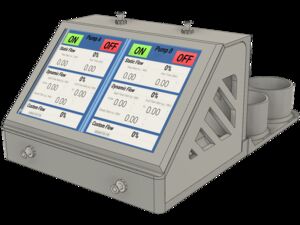
Programmable Fluidic Pumping System
"Low-cost and scalable fluidic pumping system. Investigating biological processes often requires model systems that mimic naturally occurring physiological environments. Many animal models and cell lines have served as gold standard tools for biomedical researchers to investigate biological functions in laboratories. Yet, many vital bio-activities such as hormones production rely on fluid dynamics to propagate signalling molecules at the right place and time throughout the body. In investigating such long-range communication mechanisms, a need exist to precisely mimic and control physiological fluid environments in laboratory settings. As a result, many commercial pumping systems are now available: Programmable syringe pump system Peristaltic Pumping system Pressure controller system Yet, commercial solutions come highly expensive and are difficult to customize based on application requirements." [...]
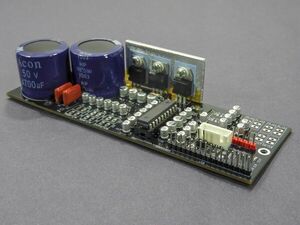
5.1 channel preamplifier
"Digitally controlled 5.1 channel audio preamplifier system to increase the gain of the multi-channel PC sound cards. This project introduces a digitally controlled 5.1 channel audio preamplifier system. This amplifier is specifically designed to increase the gain of the multi-channel PC sound cards. The main reason for building this amplifier is the limited gain received from the ASUSXonar AE sound card with the Creative Inspire T6300, 5.1 surround speaker system. Before switching to this soundcard, we had a Creative Sound Blaster Z card which provided good audio output with the above-mention speaker system. The key motivation of building this amplifier is to solve these gaining problems." [...]

Custom Wireless Keyboard! (Arduino)
"In this project we are going to be making something super useful! It is a wireless keyboard that you can connect to your PC and assign each button any shortcut or key sequence you want! I have made it in a way where you can customise the keyboard to meet your exact needs, for example, the number of buttons you want and easily configure the buttons to do whatever you want. It is also made to be very efficient to run on a coin battery for a long time! I have also made a video showcasing this keyboard and I go through each step, so check that out if you are interested. It's actually a very nice and simple project to do." [...]
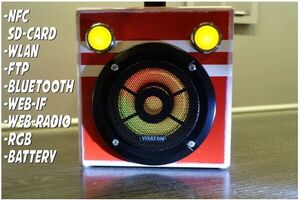
Ultimate Kids Musicbox ESP32 Based
"There are already some NFC jukeboxes. Off the shelf like those "Toni" boxes. For do-it-yourself: lots of instructables. This device should cover as much as possible, which could come into question sometime and somehow. It should have as few weak points as possible, (in which a 3-year-old could put things). Easy to use, easy to maintain and hard to destroy." [...]

Universal IR Remote Using Arduino Nano
"It becomes tedious when multiple remotes of different or same appliance lie around and you have to find each one when needed like AC, TV, Music players. to overcome this problem we will make an arduino nano based universal remote which can act as all in one remote. to make this universal remote you will require: - Arduino Nano - TSOP1738 - IR LED - Push button - Resistors - RGB LED - circuit board" [...]
Secção Videos
Videos interessantes.
That's all Folks!




